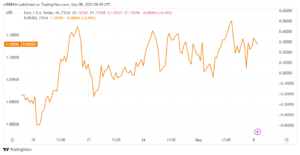The EURUSD has risen slightly at the start of the new week.
After closing above the important 1.1000 mark the previous week, the EURUSD has risen to the 1.1050 range early Monday. As markets await the Federal Reserve’s (Fed) Senior Loan Officer Opinion Survey for the first quarter, the pair’s near-term technical outlook suggests a dearth of seller interest.
The US Bureau of Labor Statistics said on Friday that Nonfarm Payrolls increased by 253,000 in April, above the market’s projection of 179,000. In addition, the unemployment rate fell to 3.4% over the same time, but annual wage inflation increased to 4.4% from 4.3%.
Despite the fact that the employment data demonstrated that labor market conditions in the United States were somewhat tight, investors refrained from expecting another Fed rate rise. In June. According to the CME Group Fed Watch Tool, the chance of the US central bank maintaining its policy rate at the upcoming meeting is still greater than 90%.
Meanwhile, the remarkable comeback in regional bank equities ahead of the weekend allowed risk flows to dominate the activity, putting extra pressure on the safe-haven US Dollar.
US stock index futures are slightly higher on the day, while the Euro Stocks 50 is up 0.2% following the opening bell.
Investors will be watching the Federal Reserve’s Loan Officer Survey for the first quarter.
The Fed’s release in the late American session may have an impact on the USD’s valuation and EURUSD movement. If bank stocks fall as a result of the Loan Officer Survey indicating a considerable tightening of financial conditions in Q1, the risk-averse market climate will prevail. The EURUSD’s upward potential may be limited, and vice versa. A similar situation might allow dovish Fed wagers to dominate the market. However, market positioning implies that there isn’t much opportunity for more US Dollar decline, at least in the short term. Market investors will also be watching central bank officials’ comments closely.
Technical Outlook
The EURUSD has returned to the ascending regression channel established in mid-March, and the four-hour Relative Strength Index (RSI) indicator soared over 50 in the European morning, indicating a bullish bias.
On the upside, 1.1080 (the conclusion of the most recent rally, the midpoint of the ascending channel) serves as strong resistance before 1.1100 (the psychological level, the static level) and 1.1140 (the upper limit of the ascending channel).

On the downside, 1.1040 (channel lower limit, 50-period SMA, 20-period SMA) provides first support before 1.1000 (psychological level, 100-period SMA). A four-hour close below the latter may entice selling, causing the EURUSD to fall to 1.0950 (Fibonacci 23.6% retracement).








